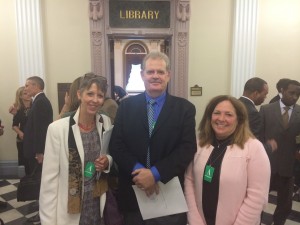ASCE Participates in White House Event on Building Green Infrastructure
October 22nd, 2014 | By: Whitford Remer
The White House Council on Environmental Quality (CEQ) and the Environmental Protection Agency (EPA) invited ASCE to participate and join a new working group called the Green Infrastructure Collaborative. The Collaborative is a broad network of federal agencies, NGO’s, and private sector entities focused on promoting and implementing green infrastructure across government and in the private sector. ASCE members and staff attended the first of several meetings this month at the White House to share and build knowledge around green infrastructure technologies and policy issues from the perspective of various stakeholders. In particular, ASCE has committed to conducting research and providing information on stormwater best management practices, low-impact development, and focusing attention of environmental and water resources engineers on sustainable development principles. See ASCE’s full commitment along with other participating organizations, including the federal government. Also on this month, CEQ released a fact sheet related to building community resilience by strengthening America’s natural resources and supporting green infrastructure. The fact sheet is part of an ongoing effort to focus on resilience following a Presidential Executive Order on Climate Preparedness issued last November. A number of important announcements were revealed in the fact sheet, including the results of a new U.S. Army Corps of Engineers (USACE) screening-level vulnerability assessment tool for coastal projects, which finds that roughly one third of USACE coastal projects are vulnerable to climate change. View more of the actions announced in the fact sheet.Protect Wisconsin’s Transportation Trust Fund — Vote “Yes” on Question 1!
October 22nd, 2014 | By: Maria Matthews
On November 4, Wisconsin voters will be asked to decide how the state can spend its transportation dollars. Question 1 will appear on the ballot statewide and if passed, will ensure that revenue allocated to the Transportation Trust Fund will not get transferred in to the state’s general fund. A vote “for” will ensure a reliable source of transportation funding without the creation of new taxes, tolls or user fees. It will also change the state of the Wisconsin Department of Transportation from a statutory agency to one provided for by the state’s constitution. Prevent the diversion of Wisconsin’s transportation funding for non-transportation purposes. When going to the polls on November 4, remember this:- A “lock box” will be created ensuring funds will be deposited into the Transportation Fund and only be able to be used for transportation-related purposes.
- All taxes and fees related to motor vehicles, aircraft, and railroads collected after December 31, 2010 would now be deposited into the Transportation Trust.
- The measure will elevate the Department of Transportation from a statutory agency to a constitutional agency.
- The measure does not create additional taxes or user fees.
Tags: 2014BallotInitiatives, infrastructure, transportation
1 Comment »
Infrastructure in Arkansas Earns D+
October 17th, 2014 | By: Infrastructure Report Card
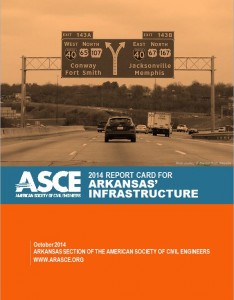 This Thursday, the Arkansas Section of the American Society of Civil Engineers released their inaugural Infrastructure Report Card for the state grading the states’ infrastructure.
Arkansas’ infrastructure received a cumulative GPA of “D+” in the 2014 Report Card for Arkansas’ Infrastructure. The seven infrastructure categories evaluated in the report include:
Roads (D+)
Drinking water (D+)
Transit (D+)
Levees (D)
Dams (D)
Bridges (C+)
Wastewater (C+)
The report noted that Arkansas has the 12th largest highway system in the nation, as well as the second highest traffic fatality rate in the country as of 2010. In addition, the state has 214 wastewater treatment facilities that will need upgrades and improvements in the next 20 years.
The Report Card, the first for Arkansas, was released during the annual ASCE Arkansas Section Conference and included a keynote address by Scott Bennett, director of the Arkansas State Highway and Transportation Department. The report was featured in both the Arkansas Democrat-Gazette and the Times-Record. The effort was led by Aaron Robinson, P.E., based in Jacksonville, Arkansas.
Read the full Arkansas Report Card
This Thursday, the Arkansas Section of the American Society of Civil Engineers released their inaugural Infrastructure Report Card for the state grading the states’ infrastructure.
Arkansas’ infrastructure received a cumulative GPA of “D+” in the 2014 Report Card for Arkansas’ Infrastructure. The seven infrastructure categories evaluated in the report include:
Roads (D+)
Drinking water (D+)
Transit (D+)
Levees (D)
Dams (D)
Bridges (C+)
Wastewater (C+)
The report noted that Arkansas has the 12th largest highway system in the nation, as well as the second highest traffic fatality rate in the country as of 2010. In addition, the state has 214 wastewater treatment facilities that will need upgrades and improvements in the next 20 years.
The Report Card, the first for Arkansas, was released during the annual ASCE Arkansas Section Conference and included a keynote address by Scott Bennett, director of the Arkansas State Highway and Transportation Department. The report was featured in both the Arkansas Democrat-Gazette and the Times-Record. The effort was led by Aaron Robinson, P.E., based in Jacksonville, Arkansas.
Read the full Arkansas Report Card
Tags: Arkansas, bridges, dams, infrastructure, levees, report, report card, roads, transit, wastewater, water
No Comments »
Vermont Infrastructure Shows Improvement in New Report Card
October 17th, 2014 | By: Infrastructure Report Card
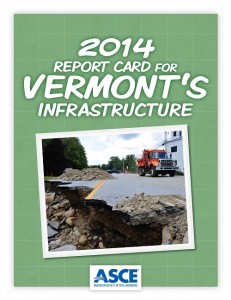 The latest Report Card for Vermont’s Infrastructure showed a slight improvement in their overall GPA to a “C.” The 2014 Report Card for Vermont’s Infrastructure is an update from 2011, when the state received a “C-” cumulative grade. The Report Card assessed bridges (C), dams (C), drinking water (C-), wastewater (D), roads (C-), and solid waste (C+).
After Tropical Storm Irene damaged the state’s infrastructure backbone in 2011, Vermont made significant investments through catch-up and emergency funding. In addition, the state’s most recent transportation funding package provided close to $700 million for transportation infrastructure, the largest transportation infrastructure investment in state history. There have also been programmatic changes. Road fatalities have been cut nearly in half since 2006 due to changes made using the Strategic Highway Safety Plan.
Led by Amanda Hanaway-Corrente, P.E. who chaired the effort and Vermont Section President-Elect Jessica Clark Louisos, P.E., the Report Card was released at a luncheon in Montpelier, which included a keynote from Sue Minter, deputy secretary at the Vermont Agency of Transportation (VTRANS) and David Mears, commissioner of the Department of Environmental Conservation.
“Vermont is poised to grow our economy as we continue to make investments into our infrastructure. The transportation funding that was signed into law in June is one example of how the state continues to focus on innovation and jobs,” said Minter.
Media coverage of the event included the Burlington Free Press and WCAX.
Read the full Vermont Report Card
The latest Report Card for Vermont’s Infrastructure showed a slight improvement in their overall GPA to a “C.” The 2014 Report Card for Vermont’s Infrastructure is an update from 2011, when the state received a “C-” cumulative grade. The Report Card assessed bridges (C), dams (C), drinking water (C-), wastewater (D), roads (C-), and solid waste (C+).
After Tropical Storm Irene damaged the state’s infrastructure backbone in 2011, Vermont made significant investments through catch-up and emergency funding. In addition, the state’s most recent transportation funding package provided close to $700 million for transportation infrastructure, the largest transportation infrastructure investment in state history. There have also been programmatic changes. Road fatalities have been cut nearly in half since 2006 due to changes made using the Strategic Highway Safety Plan.
Led by Amanda Hanaway-Corrente, P.E. who chaired the effort and Vermont Section President-Elect Jessica Clark Louisos, P.E., the Report Card was released at a luncheon in Montpelier, which included a keynote from Sue Minter, deputy secretary at the Vermont Agency of Transportation (VTRANS) and David Mears, commissioner of the Department of Environmental Conservation.
“Vermont is poised to grow our economy as we continue to make investments into our infrastructure. The transportation funding that was signed into law in June is one example of how the state continues to focus on innovation and jobs,” said Minter.
Media coverage of the event included the Burlington Free Press and WCAX.
Read the full Vermont Report Card
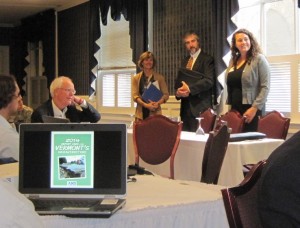
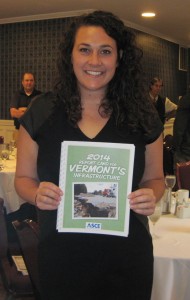
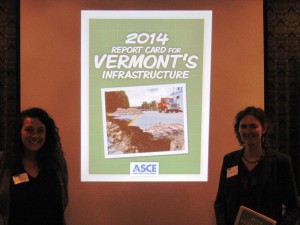
Tags: bridges, dams, grade, infrastructure, report card, roads, transportation, Vermont, wastewater, water
No Comments »
Hawaii Votes on Funding Dam and Reservoir Repairs
October 15th, 2014 | By: Maria Matthews
On November 4, Hawaii voters will decide whether “special purpose revenue bonds” will be sold as a means of generating financial assistance to dam and reservoir owners to aid in improvements or maintenance to ensure compliance with safety standards. Amendment 5, a constitutional amendment, will read as follows: “Shall the State be authorized to issue special purpose revenue bonds and use the proceeds from the bonds to offer loans to qualifying dam and reservoir owners to improve their facilities to protect public safety and provide significant benefits to the general public as important water resources?.” A vote “for” will allow the legislature to issue “special purposes revenue bonds” that will provide needed assistance to owners without placing an undue burden on the state. A similar measure was defeated by voters in 2012. In order to take effect the measure must not only win a majority of votes on this proposal but, must also win a majority of all voters in this election. This makes it ever more critical to ensure funds are available to assist all dam/reservoir owners. To ensure additional funds can be made available to improve Hawaii’s dams and reservoirs, protect public safety and preserve important water sources, remember this when you vote: ✓ Special Purpose Revenue Bonds will not create an additional burden for the state or taxpayers. ✓ Both public and private entities will have an opportunity to seek out special purpose bonds. ✓ The measure will have no effect on current or future tax rates or spending levels. ✓ Breaches not only create a public safety risk but, can cause significant damage to infrastructure in the surrounding area. Ensuring funds are available for dam and reservoir improvement is in the public interest. Amendment 5 is supported by the ASCE Hawaii Section in addition to local Chamber of Commerce and a number of agricultural and land use groups. It is also one of 15 legislative proposals endorsed by the Hawaii Department of Land and Natural Resources in 2014. Preserve the integrity of dams and reservoirs throughout the state by supporting this important ballot measure!Tags: 2014BallotInitiatives, dams, infrastructure
No Comments »
Say “No” to Aging Infrastructure Massachusetts: Vote “No” on Question 1!
October 9th, 2014 | By: Maria Matthews
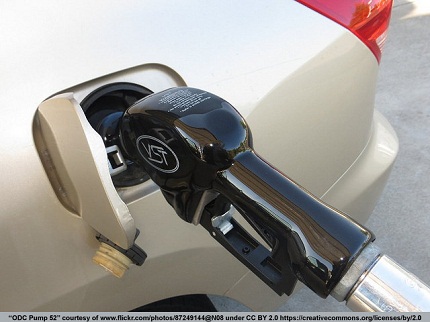 A statewide ballot question that would eliminate gas tax indexing will appear on the November ballot. The passage of Question 1 would be a step backward for the state, causing roads and bridges to fall into further disrepair.
The Boston Society of Civil Engineers Section has endorsed the Committee for Safer Roads and Bridges campaign and ASCE joins them in urging a “NO” vote on Question 1 on November 4th.
If the “Yes” votes pass the ballot measure, it would eliminate the requirement that the state’s gasoline tax:
(1) be adjusted every year by the percentage change in the Consumer Price Index over the preceding year, but
(2) not be adjusted below 21.5 cents per gallon.
If the “No” votes defeat the measure, Massachusetts will see no change to the gas increases established by the Transportation Finance Act of 2013 and retain the ability to more adequately meet its infrastructure needs.
Our aging infrastructure can’t wait. Experts say that far too many of Massachusetts bridges are structurally deficient, with many more becoming functionally obsolete. Not only is public safety put at risk when critical transportation funds are cut, but it also impedes economic growth. A safe and reliable transportation system that enables us to move goods and services and commute to work is the backbone of our economy. Repealing the indexing feature of the state’s gas tax would be a step backward.
Allowing the gas tax to remain linked to the consumer price index will:
A statewide ballot question that would eliminate gas tax indexing will appear on the November ballot. The passage of Question 1 would be a step backward for the state, causing roads and bridges to fall into further disrepair.
The Boston Society of Civil Engineers Section has endorsed the Committee for Safer Roads and Bridges campaign and ASCE joins them in urging a “NO” vote on Question 1 on November 4th.
If the “Yes” votes pass the ballot measure, it would eliminate the requirement that the state’s gasoline tax:
(1) be adjusted every year by the percentage change in the Consumer Price Index over the preceding year, but
(2) not be adjusted below 21.5 cents per gallon.
If the “No” votes defeat the measure, Massachusetts will see no change to the gas increases established by the Transportation Finance Act of 2013 and retain the ability to more adequately meet its infrastructure needs.
Our aging infrastructure can’t wait. Experts say that far too many of Massachusetts bridges are structurally deficient, with many more becoming functionally obsolete. Not only is public safety put at risk when critical transportation funds are cut, but it also impedes economic growth. A safe and reliable transportation system that enables us to move goods and services and commute to work is the backbone of our economy. Repealing the indexing feature of the state’s gas tax would be a step backward.
Allowing the gas tax to remain linked to the consumer price index will:
- Ensure the gas tax keeps up with need. We went 22 years without an increase in our gas tax causing us to fall behind other states and our roads and bridges to deteriorate.
- Enable Massachusetts to invest wisely in the creation and maintenance of infrastructure.
- Provide a more stable revenue stream so Massachusetts will not have to burden commuters and other motorists with tolls.
- Keep Massachusetts competitive in the national and global economy.
- Create jobs by maintaining a steady revenue stream that can fund investments in transportation.
Tags: 2014BallotInitiatives, gas tax, infrastructure
No Comments »
Texans Must Vote “Yes” on Designating Revenue to State Highway Fund
October 6th, 2014 | By: Maria Matthews
Texans have an opportunity to increase their state transportation funding coffers when they go to the voting booth on November 4. Proposition 1 is a statewide ballot measure that will dedicate a portion of the state’s oil and gas tax collections to the State Highway Fund. If the measure passes, $1.7 billion could be transferred to the fund in the first year alone. This would prove a significant step toward meeting the funding needs of many transportation projects. The measure, a constitutional amendment, reads as follows: “The constitutional amendment providing for the use and dedication of certain money transferred to the state highway fund to assist in the completion of transportation construction, maintenance, and rehabilitation projects, not to include toll roads.” A “yes” vote will ensure a reliable source of transportation funding without the creation of new taxes, tolls or user fees. When you talk with a neighbor about the election, remember this: ✓ Designated funds can only be used for construction, maintenance, rehabilitation, and acquiring right-of-way for public roads. ✓ If approved by voters, 50% of the money currently destined for the state’s Economic Stabilization Fund, or Rainy Day Fund, would be redirected to the State Highway Fund. ✓ The proposition also calls for the Texas Department of Transportation (TxDOT) to identify $100 million in savings to reduce long-term debt. ✓ Calls for the creation of a 10 person committee (5 State Senators, 5 State House members) to determine a “sufficient balance” for the Economic Stabilization Fund. Ultimately, voting yes is choosing to invest in mobility for Texas and a stronger economy. The measure is currently supported by the ASCE Texas Section in conjunction with the larger Move Texas Forward Coalition. Move Texas Forward is committed to improving Texas infrastructure and keeping roads capable of supporting the growth of the state. The coalition is made up of engineering societies and associations, Chambers of Commerce, transportation councils/coalitions, as well as oil and gas industry organizations. While it will not solve all of Texas’ transportation funding challenges, making funds available to the State Highway Fund is just one step in the right direction for Texas. For this reason, ASCE encourages Texans to vote “yes” on Proposition 1 in November.Tags: 2014 Election, 2014BallotInitiatives, infrastructure, transportation
4 Comments »
The Time is Now to Invest in Airports
October 2nd, 2014 | By: America's Infrastructure Report Card
Travel delays at airports have become all too common place. In fact, the surprise usually is that a flight makes it to its destination on time (or if the travel gods are feeling particularly generous, you might make it to your destination a few minutes early). Some of this is beyond anyone’s control: weather patterns and airplane mechanical problems to name a few. But part of this problem is most certainly self-imposed. Inadequate investment in the nation’s aviation system has real consequences, beyond simply making you a few minutes late for check-in at your arriving hotel. In ASCE’s 2013 Report Card for America’s Infrastructure the Society gave a grade of “D” to the aviation sector. Our Failure to Act report highlights the sobering reality that this lack of aviation sector investment has on the broader U.S. economy: a projected $313 billion in loss of GDP by 2020 and 350,000 fewer jobs throughout the economy by 2020. The Society’s dedication to this issue does not stop with economic reports, but rather this data is the gateway to engaging elected officials to act on solutions to these problems. That is why ASCE recently joined with aviation sector stakeholders, such as airports and state legislators, to supports an increase in the passenger facility charge (PFC) cap which would allow airports to raise necessary funds locally for improving the nation’s aviation infrastructure. Funds raised through PFCs are only eligible for use at the airport in which they were collected and can be used on projects to preserve or enhance the safety, security and capacity of the national air transportation system. This funding solution is expected to be under consideration when Congress turns its attention crafting to a broader Federal Aviation Authorization (FAA) reform bill early next year. Until then, you can show support for an improved aviation system by writing your Members of Congress here and using the hashtag #AirportsUnited to help spread the message. It’s time to take human error related to political gridlock out of the equation when it comes to getting travelers to their destinations safely, on-time and hopefully with a little less stress.Tags: Airports, aviation, infrastructure, transportation
1 Comment »
ASCE Members Participate in White House Summit on Infrastructure Investment
September 11th, 2014 | By: America's Infrastructure Report Card
As a part of what the White House has deemed its “Year of Action” campaign to move policy ideas and initiatives forward in the face of Congressional gridlock, the Obama Administration recently held an Infrastructure Investment Summit aimed at soliciting ideas on how to better leverage available financing to deliver projects in the transportation, water, telecommunications and energy sectors. Participants included cabinet secretaries from the departments of Treasury, Transportation and Commerce as well as leaders from industry, finance, philanthropy and state and local government. Two ASCE members, Anthony Bartolomeo, P.E., F.ASCE who is chairman of the Society’s Industry Leaders Council and Robert Victor, P.E., F.ASCE who chairs ASCE’s Committee on America’s Infrastructure which produced the Society’s national Infrastructure Report Card, participated in the day-long summit with Bartolomeo moderating a small breakout session with Treasury Secretary Jack Lew and Transportation Secretary Anthony Foxx in attendance. The goal of the meeting was to identify barriers to accelerating private investment in the US infrastructure network and develop strategies to further deploy the billions of domestic and foreign dollars currently sitting on the sidelines. The summit will inform an interagency report on the topic which is due for delivery to President Obama on November 14, 2014.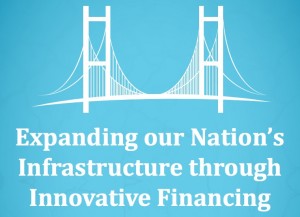 Using the summit as a platform for announcement, the U.S. Department of Transportation (USDOT) declared a $950 million TIFIA loan would be provided for the Orlando, Florida Interstate 4 highway project, which signifies the biggest TIFIA loan to date for a public private partnership (P3). USDOT also announced that it had cleared efforts by Pennsylvania DOT to utilize a $1.2 billion private activity bond allocation to replace more than 500 small bridges within a P3 arrangement. USDOT has recently launched the Build America Transportation Investment Center which released at the summit model P3 contract provisions in order to better assist project sponsors with the guidance and technical assistance necessary to complete highway toll concession arrangements. The topic of P3s is certain to receive further attention in the weeks ahead as the U.S. House of Representatives Committee on Transportation & Infrastructure is slated to release a bipartisan report on the topic which will inform their work on accelerating private sector investment in infrastructure.
Using the summit as a platform for announcement, the U.S. Department of Transportation (USDOT) declared a $950 million TIFIA loan would be provided for the Orlando, Florida Interstate 4 highway project, which signifies the biggest TIFIA loan to date for a public private partnership (P3). USDOT also announced that it had cleared efforts by Pennsylvania DOT to utilize a $1.2 billion private activity bond allocation to replace more than 500 small bridges within a P3 arrangement. USDOT has recently launched the Build America Transportation Investment Center which released at the summit model P3 contract provisions in order to better assist project sponsors with the guidance and technical assistance necessary to complete highway toll concession arrangements. The topic of P3s is certain to receive further attention in the weeks ahead as the U.S. House of Representatives Committee on Transportation & Infrastructure is slated to release a bipartisan report on the topic which will inform their work on accelerating private sector investment in infrastructure.
Tags: financing, infrastructure, Obama Administration, transportation
No Comments »
Humboldt County California's Transportation Report Card Released
September 8th, 2014 | By: Infrastructure Report Card
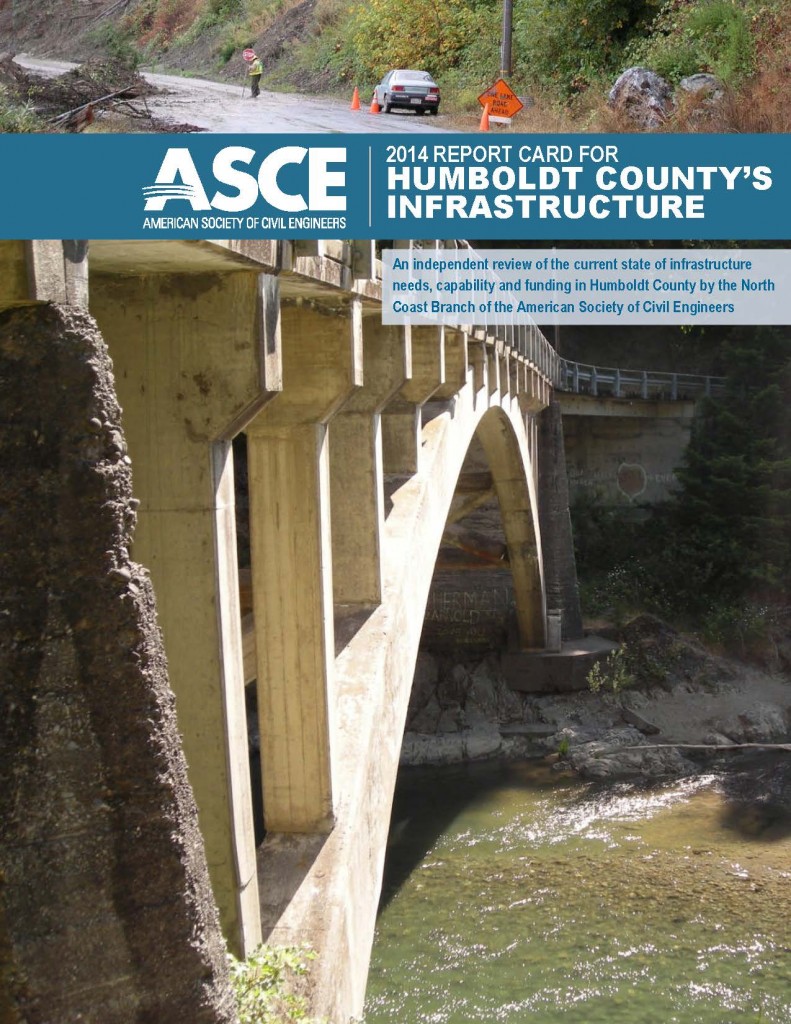 This afternoon the 2014 Report Card for Humboldt County’s Infrastructure, an independent review of the area’s transportation needs, was released by the North Coast Branch of the American Society of Civil Engineers. The Report Card gave the County’s roads a grade of D+ grade and bridges received a grade of C-.
According to the new report, Humboldt County’s locally owned roads and bridges need five times the current investment simply to maintain their current condition.
“The grades are disappointing, but not surprising to Humboldt County’s citizens who drive these roads and bridges,” said Yoash Tilles, president, ASCE North Coast Branch. “This impacts our community’s economy, safety and daily life. It is time to make the investment to improve our transportation infrastructure.”
Among the key findings of the report:
This afternoon the 2014 Report Card for Humboldt County’s Infrastructure, an independent review of the area’s transportation needs, was released by the North Coast Branch of the American Society of Civil Engineers. The Report Card gave the County’s roads a grade of D+ grade and bridges received a grade of C-.
According to the new report, Humboldt County’s locally owned roads and bridges need five times the current investment simply to maintain their current condition.
“The grades are disappointing, but not surprising to Humboldt County’s citizens who drive these roads and bridges,” said Yoash Tilles, president, ASCE North Coast Branch. “This impacts our community’s economy, safety and daily life. It is time to make the investment to improve our transportation infrastructure.”
Among the key findings of the report:
- The Tribes, Cities and the County need five times its current funding to maintain the locally-operated roads and bridges at their current condition.
- In Humboldt County, the average condition of roads is assessed as mediocre.
- The locally-owned 170 bridges within Humboldt County received the average rating of mediocre.
- The number of lives lost in car accidents in Humboldt County is approximately double the state rate according to the California Highway Safety Plan for 2014.
- To improve roads and bridges, $426 million must be invested over the next 10 years.
Tags: bridges, California, Eureka, Humboldt County, infrastructure, roads, transportation
No Comments »



 */ ?>
*/ ?>




